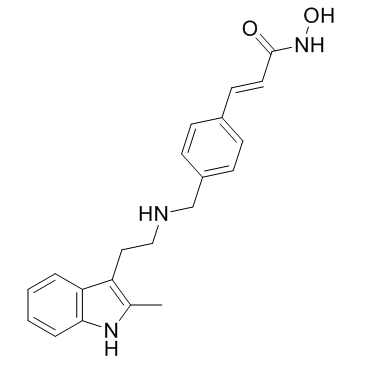
Panobinostat
CAS No. 404950-80-7
Panobinostat( LBH-589 | LBH589 | NVP-LBH589 )
Catalog No. M14388 CAS No. 404950-80-7
A potent, broad-spectrum HDAC inhibitor with IC50 of 5-20 nM in cell-free assyas.
Purity : >98% (HPLC)
 COA
COA
 Datasheet
Datasheet
 HNMR
HNMR
 HPLC
HPLC
 MSDS
MSDS
 Handing Instructions
Handing Instructions
| Size | Price / USD | Stock | Quantity |
| 5MG | 29 | In Stock |


|
| 10MG | 47 | In Stock |


|
| 25MG | 72 | In Stock |


|
| 50MG | 96 | In Stock |


|
| 100MG | 132 | In Stock |


|
| 200MG | 168 | In Stock |


|
| 500MG | 345 | In Stock |


|
| 1G | Get Quote | In Stock |


|
Biological Information
-
Product NamePanobinostat
-
NoteResearch use only, not for human use.
-
Brief DescriptionA potent, broad-spectrum HDAC inhibitor with IC50 of 5-20 nM in cell-free assyas.
-
DescriptionA potent, broad-spectrum HDAC inhibitor with IC50 of 5-20 nM in cell-free assyas; induces cell-cycle arrest, apoptosis, and histone (H3K9 and H4K8) hyperacetylation, increases mRNA levels of proapoptosis, growth arrest, and DNA damage repair genes including FANCG, FOXO3A, GADD45A, GADD45B, and GADD45G; significantly slows tumor growth derived from Meso and NSCLC cells in vivo models.Blood Cancer Approved(In Vitro):Panobinosta (LBH589) induces apoptosis of both MOLT-4 and Reh cells in a time- and dose-dependent manner. Panobinosta treatment results in histone (H3K9 and H4K8) hyperacetylation and regulation of cell-cycle control genes in Reh cells. Panobinostat exhibites potent antiproliferative activity in human NSCLC cell lines with the IC50 ranging from 5 to 100 nM.(In Vivo):Panobinosta (10, 20 mg/kg, i.p.) significantly slows tumor growth derived from Meso and NSCLC cells in vivo models. Panobinosta markedly increases acetylation of histone H3 and H4 of H69 human SCLC cells harvest from SCID mice. Panobinostat (5, 10 and 20 mg/kg i.p.) demonstrates a clear benefit of decreased tumor burden, significantly improves TTE and reduces bone density loss in a disseminated multiple myeloma mouse model.
-
In VitroPanobinosta (LBH589) induces apoptosis of both MOLT-4 and Reh cells in a time- and dose-dependent manner. Panobinosta treatment results in histone (H3K9 and H4K8) hyperacetylation and regulation of cell-cycle control genes in Reh cells. Panobinostat exhibites potent antiproliferative activity in human NSCLC cell lines with the IC50 ranging from 5 to 100 nM.
-
In VivoPanobinosta (10, 20 mg/kg, i.p.) significantly slows tumor growth derived from Meso and NSCLC cells in vivo models. Panobinosta markedly increases acetylation of histone H3 and H4 of H69 human SCLC cells harvest from SCID mice. Panobinostat (5, 10 and 20 mg/kg i.p.) demonstrates a clear benefit of decreased tumor burden, significantly improves TTE and reduces bone density loss in a disseminated multiple myeloma mouse model.
-
SynonymsLBH-589 | LBH589 | NVP-LBH589
-
PathwayCell Cycle/DNA Damage
-
TargetHDAC
-
RecptorHDAC(MOLT-4cells)|HDAC(Rehcells)
-
Research AreaCancer
-
IndicationBlood cancer
Chemical Information
-
CAS Number404950-80-7
-
Formula Weight349.4262
-
Molecular FormulaC21H23N3O2
-
Purity>98% (HPLC)
-
SolubilityDMSO: ≥ 57 mg/mL
-
SMILESO=C(NO)/C=C/C1=CC=C(CNCCC2=C(C)NC3=C2C=CC=C3)C=C1
-
Chemical Name2-Propenamide, N-hydroxy-3-[4-[[[2-(2-methyl-1H-indol-3-yl)ethyl]amino]methyl]phenyl]-, (2E)-
Shipping & Storage Information
-
Storage(-20℃)
-
ShippingWith Ice Pack
-
Stability≥ 2 years
Reference
1. Crisanti MC, et al. Mol Cancer Ther. 2009 Aug;8(8):2221-31.
2. George P, et al. Blood. 2005 Feb 15;105(4):1768-76.
3. Scuto A, et al. Blood. 2008 May 15;111(10):5093-100.
molnova catalog



related products
-
Belinostat
Belinostat is a novel hydroxamic acid-type histone deacetylase (HDAC) inhibitor with antineoplastic activity.
-
Marbostat-100
Marbostat-100 is a potent, selective HDAC6 inhibitor with Ki of 0.7 nM.
-
Resminostat
A potent inhibitor of HDAC1/3/6 with IC50s of 43-72 nM.



 Cart
Cart
 sales@molnova.com
sales@molnova.com


